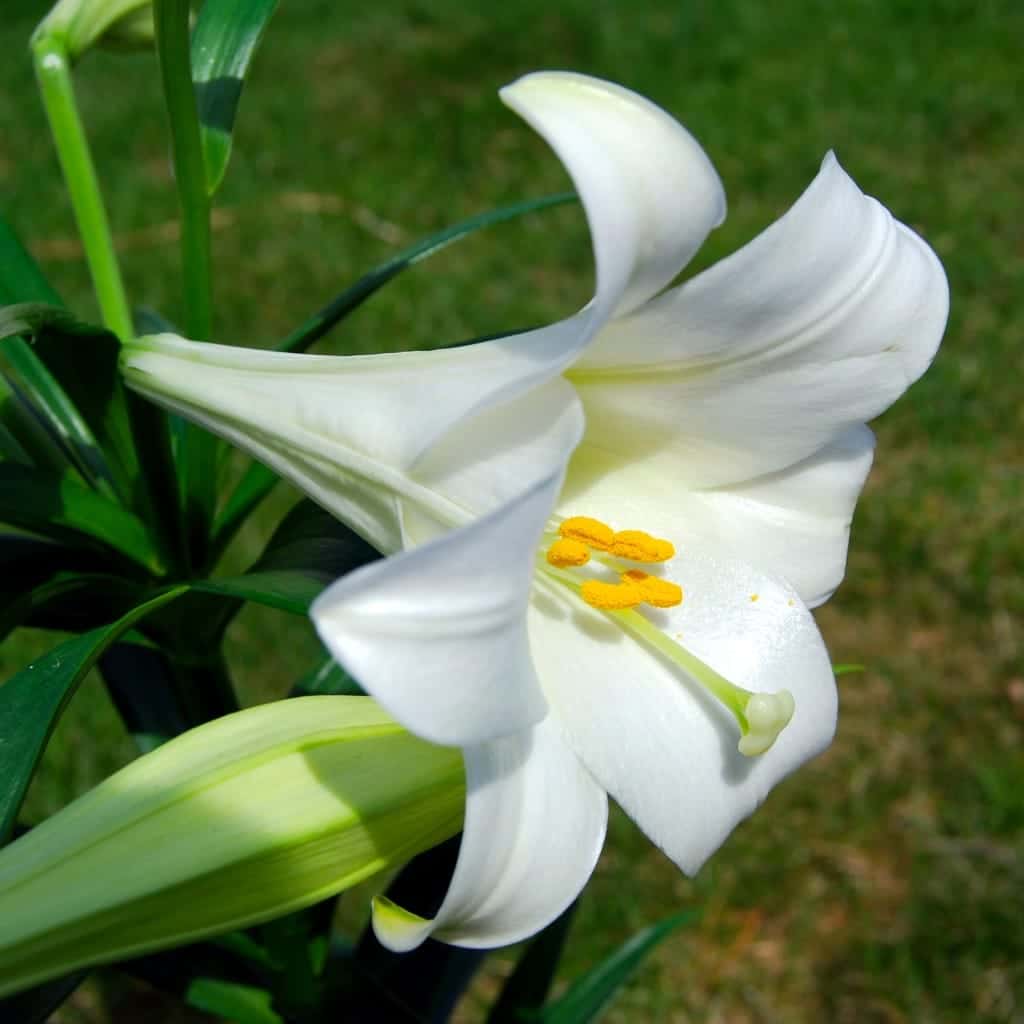Source(s):
- Bob Polomski, Extension Consumer Horticulturist.
- Al Pertuit, Extension Floriculture Specialist, Clemson University.
The white, trumpet-shaped flowers of the Easter lily (Lilium longiflorum) have become the traditional time-honored symbol of beauty, hope and life during the Easter season. Potted flowering Easter lilies can be grown indoors and planted in the garden with the onset of warmer temperatures.
When purchasing a potted Easter lily, select a high quality plant. Select a well-balanced plant that looks attractive from all angles. The rich, green leaves should be dense and plentiful from the top down to soil level. Look for a lily with one or two open or partly opened flowers and three or more unopened buds. The puffy buds will open up within a few days, while the tighter ones will open over the next several days.
Be wary of Easter lilies displayed in paper, plastic or mesh sleeves. The protective sleeves are used for shipping and should have been removed upon arrival at the store. While the packaging may seem convenient, the quality of the plants will deteriorate if they are left sleeved too long. Also avoid waterlogged plants, especially if the plant looks wilted. This could be a sign of root rot.
In the home, place your Easter lily near a window that receives bright, indirect natural daylight. Avoid direct sunlight. Easter lilies prefer somewhat cooler temperatures. Ideally, the daytime temperature should be 60 to 65 °F with slightly cooler night temperatures. Avoid placing plants near drafts, and avoid exposure to excess heat or dry air from appliances, fireplaces or heating ducts.
Keep the potting medium moist. Water the plant thoroughly when the soil surface feels dry, but avoid overwatering. If the pot is wrapped in decorative foil, be careful not to let the plant sit in trapped, standing water. Remove the plant from decorative pots or covers and water until it seeps out of the pot’s drain holes. Repeat this several times. Allow the plant to drain for a few minutes before putting it back into its decorative cover.
As the flowers open and mature, remove the yellow anthers before the pollen starts to shed. This gives longer flower life and prevents the pollen from staining the white flowers. When a mature flower starts to fade and wither, cut it off to keep the plant looking attractive.
After the last flower has withered and has been cut away, the Easter lily can be planted in the garden after the danger of frost has passed. Prepare a well-drained garden bed in a sunny location amended with organic matter such as compost. Good drainage is the key for success with lilies. To ensure adequate drainage, create a raised garden bed by moving soil to the top a few inches higher than the surrounding soil level. Also, adjust the soil pH to 6.5 to 7.0.
Plant the Easter lily bulbs 6 inches deep from the base of the bulb to the top of the mulched surface, assuming at least a 2-inch layer of mulch. Plant them 4 to 6 inches apart. The hole should be wide enough so the roots can be easily spread out. Work the soil in around the roots, and water them in immediately after planting.
Lilies like their “feet in the shade and their heads in the sun.” Mulch with a 2-inch layer of compost, pine straw or shredded leaves. Mulching helps conserve moisture in between waterings, suppresses weed growth, keeps the soil cool and provides nutrients as it decays.
As the leaves and stems of the original plants begin to turn brown and die back, cut them back just above a healthy leaf on the stem. Wait until the leaves and stems have turned brown before removing them. New growth will soon emerge. It is unlikely that a second flowering will occur later in the summer. Easter lilies, which were forced to flower under controlled greenhouse conditions in March, will flower naturally in June or July the following and subsequent years and will reach a height of 3 feet or more.
In the fall, when the lily stalks have matured and turned yellow, you can cut them back to soil level. When they are completely dry, the stalks can be pulled out easily.
During the winter months, maintain a generous layer of mulch. Carefully remove the mulch in the spring to allow new shoots to come up. Fertilize with a complete fast-release fertilizer such as 8-8-8 when the new shoots emerge and monthly until flowering. Conversely, a slow-release fertilizer can be applied just once during the growing season when new shoots emerge in the spring. Apply the fertilizer to the soil around each plant about 2 inches from the stem and water it in.
Center Publication Number: 83
- Forcing Bulbs Indoors - September 24, 2013
- Easter Lily - September 23, 2013
